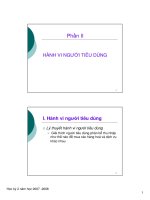Slide hành vi người tiêu dùng chapter 7 consumers as decision makers
Bạn đang xem bản rút gọn của tài liệu. Xem và tải ngay bản đầy đủ của tài liệu tại đây (1.1 MB, 43 trang )
.c
om
Chapter 7
ng
th
an
co
ng
Individual Decision Making
cu
u
du
o
CONSUMER
BEHAVIOR, 8e
Michael Solomon
CuuDuongThanCong.com
/>
Chapter Objectives
.c
om
When you finish this chapter you should understand
why:
ng
• Consumer decision making is a central part of
du
o
ng
th
an
co
consumer behavior, but the way we evaluate and
choose products (and the amount of thought we put
into these choices) varies widely, depending upon
such dimensions as the degree of novelty or risk in
the decision.
• A decision is actually composed of a series of
cu
u
stages that results in the selection of one product
over competing options.
• Our access to online sources is changing the way
we decide what to buy.
Hoang Duc Binh, 2008
CuuDuongThanCong.com
/>
Chapter Objectives (cont.)
ng
.c
om
• Decision making is not always rational.
• Consumers rely upon different decision rules when
co
evaluating competing options.
th
cu
u
du
o
ng
to make decisions.
an
• We often fall back on well learned “rules-of-thumb”
Hoang Duc Binh, 2008
CuuDuongThanCong.com
/>
Consumers as Problem Solvers
.c
om
• Consumer purchase = response to problem
• After realization that we want to make a
an
th
•
•
co
ng
purchase, we go through a series of steps in
order to make it
Can seem automatic or like a full-time job
Complicated by consumer hyperchoice
cu
u
du
o
ng
• Decision-making process
Click photo to view
Quicktime video on General
Electric and consumer shopping
Hoang Duc Binh, 2008
CuuDuongThanCong.com
/>
cu
u
du
o
ng
th
an
co
ng
.c
om
Decision-Making Process
Hoang Duc Binh, 2008
Figure 9.1
CuuDuongThanCong.com
/>
Decision-Making Perspectives
.c
om
• Rational perspective: consumers:
• Integrate as much information as possible with
cu
u
du
o
ng
th
an
co
ng
what they already know about a product
• Weigh pluses and minuses of each alternative
• Arrive at a satisfactory decision
Hoang Duc Binh, 2008
CuuDuongThanCong.com
/>
Decision-Making Perspectives (cont.)
.c
om
• Other models of decision making:
• Purchase momentum: occurs when consumers
cu
u
du
o
ng
th
an
co
ng
buy beyond needs satisfaction
• Behavioral influence perspective: consumers buy
based on environmental cues, such as a sale
• Experiential perspective: consumers buy based
on totality of product’s appeal
Hoang Duc Binh, 2008
CuuDuongThanCong.com
/>
cu
u
du
o
ng
th
an
co
ng
.c
om
Continuum of Buying Decision Behavior
Hoang Duc Binh, 2008
Figure 9.2
CuuDuongThanCong.com
/>
Types of Consumer Decisions
co
ng
.c
om
• Extended problem solving:
• Initiated by a motive that is central to self-concept
• Consumer feels that eventual decision carries a
fair degree of risk
ng
th
an
• Limited problem solving:
• Buyers not as motivated to search for information
du
o
u
•
or to evaluate rigorously
Buyers use simple decision rules to choose
cu
• Habitual decision making:
• Choices made with little to no conscious effort
Hoang Duc Binh, 2008
CuuDuongThanCong.com
/>
Stage 1: Problem Recognition
.c
om
Occurs when consumer sees difference between
current state and ideal state
th
Marketers can create:
an
co
ng
• Need recognition: actual state moves downward
• Opportunity recognition: ideal state moves upward
du
o
product category
ng
• Primary demand: encourage consumers to use
cu
u
• Secondary demand: persuade consumers to use
specific brand
Hoang Duc Binh, 2008
CuuDuongThanCong.com
/>
cu
u
du
o
ng
th
an
co
ng
.c
om
Problem Recognition: Shifts in Actual or
Ideal States
Hoang Duc Binh, 2008
Figure 9.3
CuuDuongThanCong.com
/>
Stage 2: Information Search
.c
om
• Information search: process by which consumer surveys the
co
ng
environment for appropriate data to make reasonable decision
an
Prepurchase versus Ongoing Search
ng
th
Prepurchase Search
Ongoing Search
Involvement with
purchase
Involvement with product
Motives
Making better purchase
decisions
Building a bank of
information for future use
Better purchase
decisions
Increased impulse buying
Outcomes
cu
u
du
o
Determinants
Hoang Duc Binh, 2008
Table 9.2
CuuDuongThanCong.com
/>
Internal versus External Search
.c
om
• Internal search
• Scanning memory to assemble product
ng
alternative information
th
an
co
• External search
• Obtaining information from ads, retailers,
cu
u
du
o
ng
catalogs, friends, family, people-watching, Web
sites
Hoang Duc Binh, 2008
CuuDuongThanCong.com
/>
Deliberate versus “Accidental” Search
.c
om
• Directed learning: existing
an
co
ng
product knowledge obtained
from previous information
search or experience of
alternatives
ng
th
• Incidental learning: mere
exposure over time to
conditioned stimuli and
observations of others
cu
u
du
o
Click photo for
Consumerreports.org
Hoang Duc Binh, 2008
CuuDuongThanCong.com
/>
The Economics of Information
.c
om
• Consumers will gather as much data as needed to
ng
make informed decisions
• We will collect most valuable information first
an
co
• Variety seeking: desire to choose new alternatives
cu
u
du
o
ng
th
over more familiar ones
Hoang Duc Binh, 2008
CuuDuongThanCong.com
/>
Do Consumers Always Search Rationally?
.c
om
• Some consumers avoid external search, especially
ng
with minimal time to do so and with durable goods
(e.g. autos)
th
an
co
• Symbolic items require more external search
• Brand switching: we select familiar brands when
ng
decision situation is ambiguous
du
o
• Variety seeking: desire to choose new alternatives
cu
u
over more familiar ones
Hoang Duc Binh, 2008
CuuDuongThanCong.com
/>
Biases in Decision-Making Process
.c
om
• Mental accounting: framing a problem in terms of
gains/losses influences our decisions
co
ng
• Sunk-cost fallacy: We are reluctant to waste
something we have paid for
ng
th
an
• Lost aversion: we emphasize our lost more than gain
• Prospect theory: risk differs when consumer faces
cu
u
du
o
options involving gains versus those involving
losses
Hoang Duc Binh, 2008
CuuDuongThanCong.com
/>
cu
u
du
o
ng
th
an
co
ng
.c
om
Ad Age Poll: Importance of Brand
Attributes
Hoang Duc Binh, 2008
Figure 9.4
CuuDuongThanCong.com
/>
cu
u
du
o
ng
th
an
co
ng
.c
om
Amount of Information Search and
Product Knowledge
Hoang Duc Binh, 2008
Figure 9.5
CuuDuongThanCong.com
/>
Perceived Risk
.c
om
• Perceived risk: belief that
du
o
ng
th
an
co
ng
product has negative
consequences
• Expensive, complex, hard-tounderstand products
• Product choice is visible to
others (risk of embarrassment
for wrong choice)
cu
u
• Risks can be objective (physical
danger) and subjective (social
embarrassment)
Hoang Duc Binh, 2008
CuuDuongThanCong.com
/>
cu
u
du
o
ng
th
an
co
ng
.c
om
Five Types of Perceived Risk
Hoang Duc Binh, 2008
Figure 9.6
CuuDuongThanCong.com
/>
Discussion
.c
om
• Choosing a brand/product among available
ng
alternatives requires much of the effort that goes
into a purchase decision.
th
an
co
• Which is the greater problem for a consumer:
• Not having enough choices or having too many
du
o
cu
u
• Why?
ng
choices?
Hoang Duc Binh, 2008
CuuDuongThanCong.com
/>
Identifying Alternatives
.c
om
• Extended problem solving = evaluation of several
co
ng
brands
• Occurs when choice conflicts arouse negative
emotions (involving difficult trade-offs)
th
an
• Habitual decision = consider few/no brand
cu
u
du
o
ng
alternatives
Hoang Duc Binh, 2008
CuuDuongThanCong.com
/>
Identifying Alternatives (cont.)
.c
om
• Evoked set versus consideration set
• We usually don’t seriously consider every brand
th
an
co
ng
we know about.
• In fact, we often include only a surprisingly small
number of alternatives in our evoked set.
ng
• Marketers must focus on getting their brands in
cu
u
du
o
consumers’ evoked set.
• We often do not give rejected brands a second
chance.
Hoang Duc Binh, 2008
CuuDuongThanCong.com
/>
Categorizing Products
.c
om
• We evaluate products in terms of what we already
know about a (similar) product.
an
co
ng
• Evoked-set products usually share similar features
• When faced with a new product, we refer to
ng
th
existing product category knowledge to form new
knowledge.
du
o
• Marketers want to ensure that their products are
cu
u
correctly grouped in knowledge structures.
• Jell-O gelatin flavors for salads
Hoang Duc Binh, 2008
CuuDuongThanCong.com
/>









